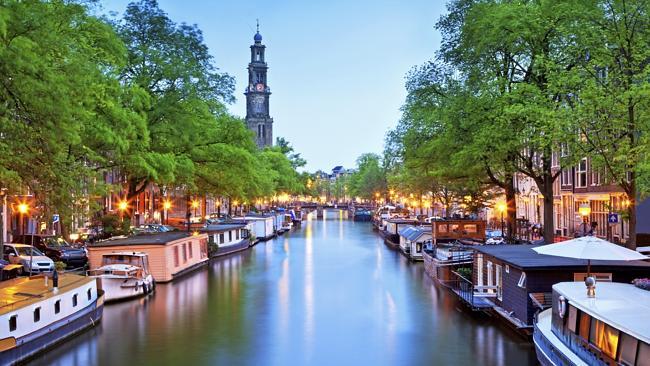Amsterdam’s canals: city waterways charm in good weather, or bad
It is a chilly summer’s day in Amsterdam and there is water everywhere, in the city’s canals and falling from the sky.

It is a chilly summer’s day in Amsterdam and there is water everywhere, moving gently through the city’s canals and falling from the sky. It has been wet since our arrival this morning, at first an incessant drizzle but now a steady rain which, more than one local has announced, is due to remain for precisely 15 hours.
With limited time in the city, everyone suggests we therefore stay indoors all day and explore the famed Rijksmuseum. Counter-intuitively we head for the canals that cross this pretty European city and are among its most enchanting features.
Once open sewers, their now clear, cool waters span close to 100km and provide a novel map for exploring Amsterdam’s city hub. The scene varies between streets, but wherever you go expect to see block after block of handsome houses, their countless window-boxes filled with bright geraniums.
The canals are charming even in bad weather, as it turns out, and it seems we are hardly alone in our assessment. Several dozen passengers are already on board our glass-ceilinged Rederij Plas boat as we alight from a wharf near the city’s central train station.
Vessels leave every 15 minutes from multiple locations and fares for a one-hour cruise start at €10 ($14.85). The views, even amid the steady rain, are charming, as we glide under the first of many impossibly low stone bridges. Past the vast parking lot at that central train station, which has space for 8000 bikes, we spot the Renzo Piano-designed NEMO Science Museum, before turning back towards the site of the old city walls, and heading through several of the sea locks still in operation.
We pass quaint cafes and marijuana-scented coffee shops and gracious old canal houses with distinctive facades. Several are also noticeably skewed, courtesy of the city’s water table and the havoc it can wreak on ageing foundations.
Our progress is steady but precise; at times the gap between the canal walls is so narrow that we ease through with just centimetres to spare.
Just as intriguing as the streetscape is the street life. Cyclists in vividly coloured raincoats zoom across the overhead bridges, at the peril of meandering tourists too busy taking in the views to be aware of the ubiquitous bike lanes. Elderly ladies stroll slowly beneath well-used umbrellas.
Cafes are bustling and the lights are on at several of the canal houses; many of the lower levels have been converted into small offices, and inside we spy colleagues meeting around small tables or finessing designs on a computer screen.
As we move through the canals, an automated commentary provides limited details about the city’s past in multiple languages. Our captain adlibs a few extra anecdotes but we would be just as happy with silence as the rain continues to fall, and we stay snug and dry inside our flat-bottomed boat.
As we return to the wharf, a family of ducks is sitting contentedly on a wooden platform by the water’s edge. They seem a fortuitous reminder that there are many ways to see Amsterdam, but nothing quite so special as the perspective you gain from being out on the water.



